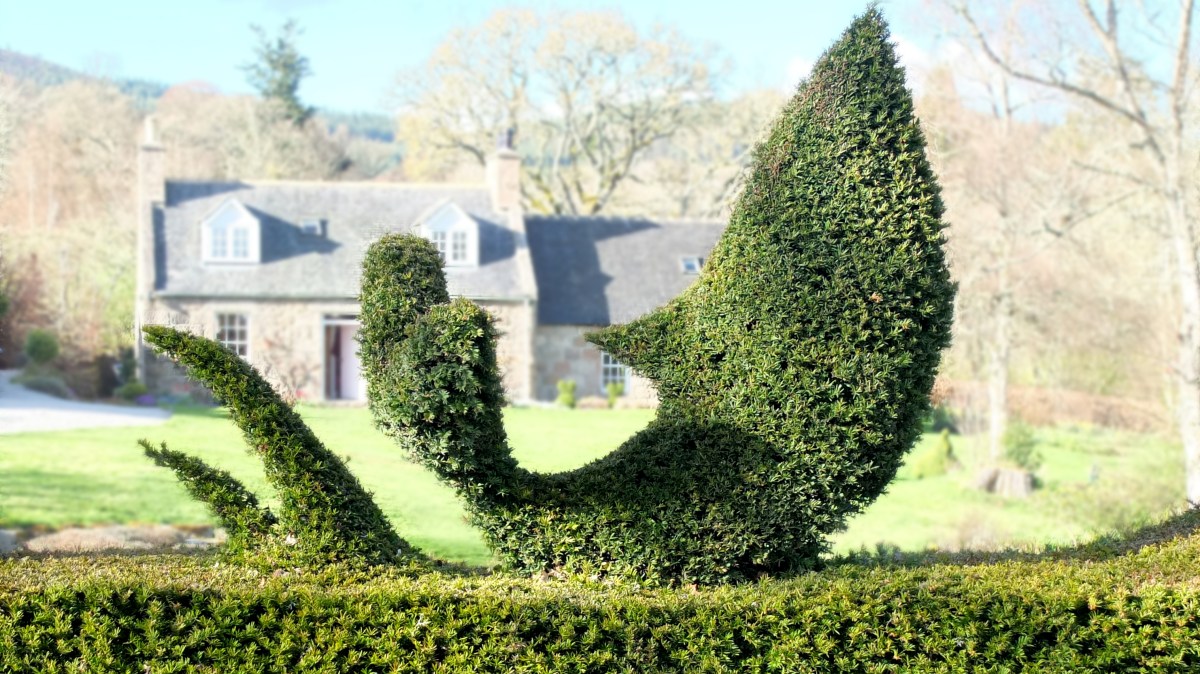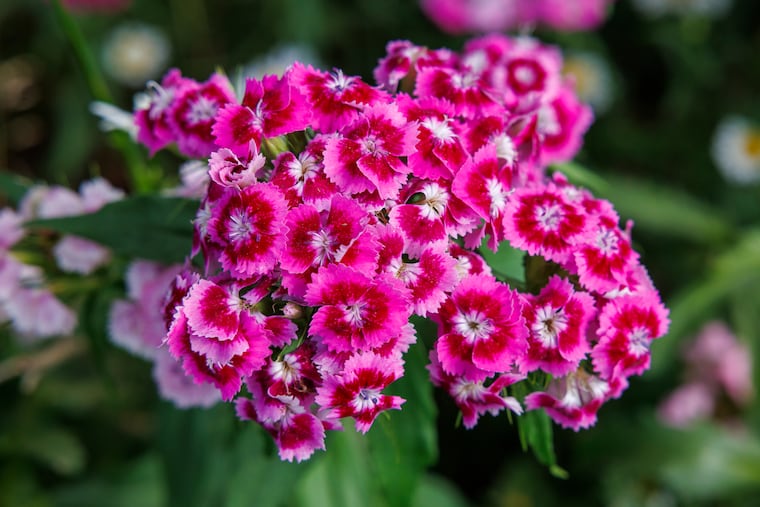“I’ve seen a man playing a piano in honeysuckle and full-scale racehorses,” says Michael Buck, head of horticulture at Creepers wholesale nursery in Surrey, and a judge for the Henchman Topiary Awards. One of his all-time favourite pieces was cut from 40 yew trees and stands four metres high. “It looks like my grandma’s blancmange mould. You walk inside and it’s [like] a room. You could put beanbags in there and chill out.”
Meanwhile, David Hawson, the winner in the home gardener category of the inaugural Henchman awards last year, had transformed his giant yew hedge into scenes from the novel Moby-Dick as well as various British birds. With topiary, the only limit is your imagination.
Topiary is an ancient art but it is booming today. The symmetry of the traditional parterre found in stately home gardens is still popular but it has been adapted to suit all types of outdoor spaces, including much smaller, urban gardens, says Andy Bourke, the topiarist owner of the Hedge Barber in Rutland, and another Henchman judge. People like geometric shapes, cones and pyramids for their gardens, he says. Other popular designs are balls, beehives, cloud shapes, either cut into the top of a hedge or on stems, and birds — especially peacocks, which were historically seen as a symbol of a homeowner’s wealth and status.
Selecting the right plant is the first step
There is a wider choice than the old favourites of box and yew, but some species’ natural growth patterns lend themselves better to certain shapes. Selecting a healthy specimen, cutting it at the right time of year and knowing its speed of growth are all crucial to success, Bourke says. If you make a mistake with the slower-growing box or yew, it will take more time to refill. A faster-growing plant such as privet will hide your mistakes more quickly but it does need more frequent clipping to keep its shape.
Geometric topiary in the gardens at Levens Hall in Kendal, Cumbria
GETTY
More shapes at Levens Hall
ALAMY
“That’s the trade-off,” Bourke adds. “If you make a mistake with privet for example, it grows out more quickly but you have to clip it more often — and there’s more chance of making a mistake.”
Rather than rush out to buy a plant to experiment with, you could start with an existing one in your garden.
“Some of the best topiary I’ve seen is with pittosporum that has been in people’s gardens for 20 or 30 years,” Buck, 37, says. “You’re walking past and you see this enormous pitto where they’ve either taken the lower branches off to create a beehive or they’ve taken off branches damaged by weather to create a unique shape: a cloud, or an organic head like a broccoli.”
• 12 easy money-saving tips for your garden
Decide what you want to create before you start
For a novice, curves are easier than symmetrical shapes, Bourke, 38, says.
“Some of the most simple-looking shapes are the most challenging, for example the geometric parterres, squares and pyramids — shapes where you’ve got straight lines,” he says. “One I find the most challenging is the pyramid. Because you’re working with straight lines, the angles have to be symmetrical on all of the sides, the point has to be central and the base has to be square. People think they’re simple because they look simple, but the minute it looks simple is the minute you can spot a mistake.” Curves are more forgiving: “As long as you can make out what it is, there’s no real right or wrong. After all, every peacock you see is different. Some have long necks or long tails, others don’t have a neck, just a head on a body with a tail. Some have the tail up, some have it down.”
Andy Bourke cuts mostly by eye
INSTAGRAM: @THE_HEDGE_BARBER
Snip little bits at a time and stand back frequently to assess the shape from several angles. Bourke cuts mostly by eye. However, for trickier shapes he occasionally uses team members, string lines or spirit levels to guide him. On rare occasions, he has resorted to using a frame.
“I did happy and sad masks for a theatre. The framework was created then the privet was planted inside and as it grew up through the framework, we clipped it to shape. Because the topiary had holes for the eyes and the mouth it needed a framework to keep it rigid.”
For smaller shapes of up to about six feet, use secateurs and hand shears for a close cut. For bigger topiary you will need a power hedge cutter. Ensure your tools are razor sharp and clean.
“I work with a bucket of water with disinfectant or even household bleach in it and dip my tools every now and then as I’m working. So if you do come across a patch of disease you’re keeping it contained where it is rather than spreading it across the whole garden,” Bourke adds.
A topiary tribute to the King’s coronation was an entry in last year’s Henchman awards
Be patient and keep honing your shape each season
Topiary does not have to be evergreen. Deciduous plants such as hornbeam (Carpinus betulus) and beech (Fagus sylvatica) can transform your garden in winter.
“Topiary is redefined when you look at it with light behind it, because the silhouette and intricacy of the beautiful stem and branch structure without its leaf are stunning. You have a new aspect in your garden that has always been there but when the seasons change it stands up and is counted when nothing else is going on. The shape is still very much there,” Buck says.
As with grasses and seedheads, deciduous topiary can look amazing with a touch of frost or strung with spider’s webs, and with lighting, Bourke says. Autumn colours are another benefit.
A box parterre restored by Andy Bourke (location undisclosed)
INSTAGRAM: @THE_HEDGE_BARBER
Once you have selected your plant, just be brave and have a go, Buck adds. “You can get paralysis by overanalysis. Go with the flow and if doesn’t go where you want, then work with that unique shape instead.”
Bourke agrees. For him, the enjoyment comes from being endlessly creative.
“You’re never going to achieve absolute perfection. There is always going to be someone who is better than you, from whom you could learn and gain ideas, and who can help you develop. That’s part of what topiary is. You’re always learning.”
• How to make your garden chic this summer — whatever its size
Plant suggestions for topiary
Yew (Taxus baccata)
Good for all sizes of topiary but especially bigger pieces. Tough, moderate grower, versatile except its dislike for wet soil. Can be cut year-round except in frost.
Box (Buxus sempervirens)
Dense, versatile, tiny-leaved, slow-growing — good for small and medium pieces. Avoid cutting in wet weather. Given the prevalence of box blight, fungal disease and the box caterpillar, if you are not prepared to properly maintain box or take the risk, try these alternatives:
Pittosporum
Evergreen, fast-growing, small leaves. Not all species are hardy throughout the UK. Good for balls and beehives.
Sheep fashioned from privet
ALAMY
Privet (Ligustrum)
Tough evergreen, fast-growing so will need more frequent clipping (perhaps four times a year) to keep in shape. Good for all shapes.
Thuja
Evergreen conifer, a fast-grower that will reshoot quickly to cover mistakes but it needs clipping more frequently to retain its shape. Good for spirals.
Bonsai created with Japanese holly
ALAMY
Japanese holly (Ilex crenata)
Dense, slow-growing, small-leaved evergreen, good for smaller shapes such as balls, cones and spirals. Can be fussy with growing conditions.
Beech (Fagus sylvatica)
Deciduous, though can retain some leaves. Tough, versatile and can be cut in winter except in frost. Good for medium and larger shapes.
A row of shaped hornbeam
ALAMY
Hornbeam (Carpinus betulus)
Same as beech.
Osmanthus
Dense, slow-growing, hardy evergreen with fragrant flowers. Wide-growing so it’s popular for mushroom shapes with a domed top and multiple stems underneath.
Note: generally it is best to start your topiary in spring
Henchman Topiary Awards 2025, henchman.co.uk (closing date for entries is May 31)
Find more daily Property & Home content here












